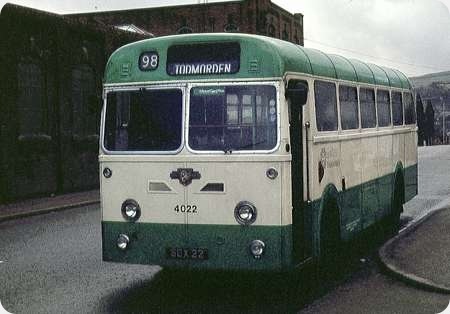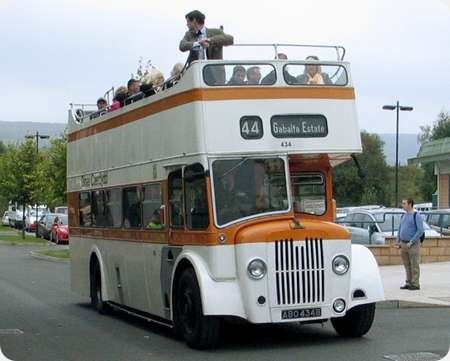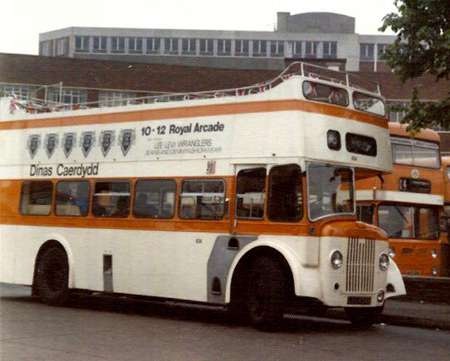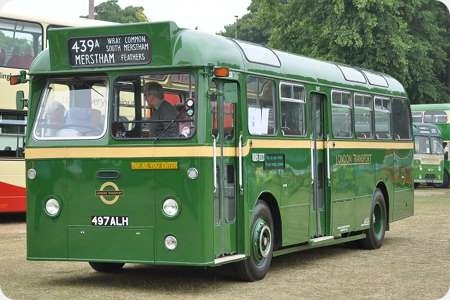West Yorkshire PTE – Leyland Leopard – SCX 22 – 4022
West Yorkshire PTE
1961
Leyland Leopard L1
Roe B44F
Huddersfield JOC purchased a quartet of Roe bodied single deckers in 1961, two on Reliance 2MU2R chassis and two on Leyland Leopard L1, only available at that time with manual gearbox. This was against the run of play for Huddersfield who had standardised on pre select / semi automatic transmission for many years. In fact it was only with the acquisition of Hansons later in the 1960s that a few more manual gearbox buses entered the fleet. I remember journeys home from work on what is a pretty hilly route on one of the Leopard pair where the drivers really struggled with the heavy clutch and ponderous gearchange. Considering that Sheffield operated a reasonable number of similar buses on equally hilly duties apparently without undue difficulty, it does emphasise the unsuitability of the inclusion of these buses within the Huddersfield fleet. I wonder what inducements Leyland offered to encourage their purchase?
By 1974, the bus had become part of the PTE fleet and as an aid to standardisation (both of buses and drivers) I transferred the pair to Todmorden Depot where they joined similar East Lancs and Willowbrook bodied machines. They were only marginally more popular there as Huddersfield had specified an enclosed driver’s cab with access from an offside door rather than the more open aspect of the Todmorden machines but we eked out a few more years service before they could be gracefully retired.
The photo is taken outside Todmorden Depot on a typically murky day in January 1977. I refrain from making any comment about the livery!
Photograph and Copy contributed by Ian Wild
13/04/15 – 07:43
Interesting thought about the livery, Ian! Of course, were the vehicle a few years newer, it might have been called upon to masquerade as a doll and that, I’m sure, would have would have been even more unwelcome in these columns.
Pete Davies
14/04/15 – 07:04
Ian and Pete, you beat me to it as regards commenting on the colour scheme – I was about to say that at least it could claim to BE a livery and, oh, if only West Yorkshire and the rest of the Country could still be served by such civilised looking vehicles today instead of the notorious and meaningless funereal white, lilac and purple of you know who. Also this bus has another advantage – windows which can be seen out of.
I think I recall correctly that these initial PTE colours were "buttermilk and emerald."
Chris Youhill
14/04/15 – 07:05
You must explain the doll! I don’t think that this livery looked all that bad and was fairly traditional. It was all downhill after that.
Joe
14/04/15 – 07:05
Can anyone confirm that Todmorden (Millwood) bus garage is the oldest in the country in continuous use (since 1907)?
Geoff Kerr
14/04/15 – 07:06
Following withdrawal it was used for a number of years by Kenedy’s Film Services of Morely as a catering vehicle along with the very first Leeds Swift and an ex Morecambe example with Pennine bodywork. A picture of 4022 in this guise can be found on www.sct61.org.uk
Chris Hough
14/04/15 – 10:29
Chris I think the green was officially called Verona green When the PTE adopted Metrobus as a fleet name the green was extended to below the windows and the roof changed from green to buttermilk.
Chris Hough
14/04/15 – 10:30
I seem to remember reading somewhere that the purchase of these two vehicles with manual gearboxes was a ‘mistake’. Around the same time Huddersfield had bought Titans with semi-automatic transmission and perhaps thought the Leopards would be similarly equipped. The later PSU Leopards were of course offered with semi-automatic transmission as an option to manual.
Philip Halstead
14/04/15 – 11:10
I can come up with at least a couple of London garages with longer lives than Todmorden, Geoff.
HL (Hanwell) Garage has been continuously open since 1901, originally being a London United tram depot, then an LT trolleybus, then bus garage.
WH (West Ham) Garage has been continuously open since 1905, originally being West Ham Corp’n’s tram depot, then an LT trolleybus, then bus garage.
Chris Hebbron
14/04/15 – 16:21
I know there is the wellknown tale of Western SMT buying some Daimler halfcab coaches assuming they would have Gardner engines only to find they arrived as CVD6’s, then when Daimler refused to swap them they sold them off straight away, but otherwise I must say that I find it very difficult to imagine that a major operator could buy something by mistake – particularly in the case of a municipality.
I have somewhere deep in my collection some tender documents for new halfcab chassis and bodies drawn up by Salford City Transport for consideration by prospective bidders in the 1960’s. Their required specification went into the most minute detail, and must have taken their Chief Engineer a considerable amount of time and effort to produce, as well as giving the bodybuilders in particular quite a headache working out how to modify their standard model in order to comply and win the bid.
John Stringer
14/04/15 – 16:21
Chris – yes, but I really meant to say "in continuous use by buses". Those you mention started life as tram depots. Millwood was of course used by buses from the outset as Todmorden never had trams.
(I don’t understand the doll reference either!)
Geoff Kerr
14/04/15 – 16:22
I was referring to the Worst Bus "Barbie" livery. On some former Yorkshire Rider vehicles which came to Southampton, this supposed livery was on vinyl sheets, rather than painted on.
Pete Davies
15/04/15 – 05:56
Hello again John, Would love to see those Salford tender documents, if you can post them. The Fleet Engineer at Frederick Road, was a Mr Brougham, who I came to know in the mid 60’s when I started working in the offices for SCT. He was known as a ‘stickler’ and things had to be just right. However, as is history tells, Daimler got the order, 45 CVG6’s and 2 CRG6Lx’s with AEC the 10 saloons and Leyland, just 2 PDR1’s But Leyland then went on to supply the fleet pretty well exclusively excepting 3 more CRG6LX’s and the 2 infamous CCG6s (which along with Manchester’s – have their own story)
Mike Norris
19/04/15 – 07:40
The answer may indeed lie in London here are two not former tram depots.
Chelverton Road, Putney opened in 1888 with Horse buses and must have been one of the first,still open operated by Go Ahead London. Cricklewood, opened 1898 with horse buses and was the LGOCs first motor bus garage, still open operated by Metroline.
Patrick Armstrong




